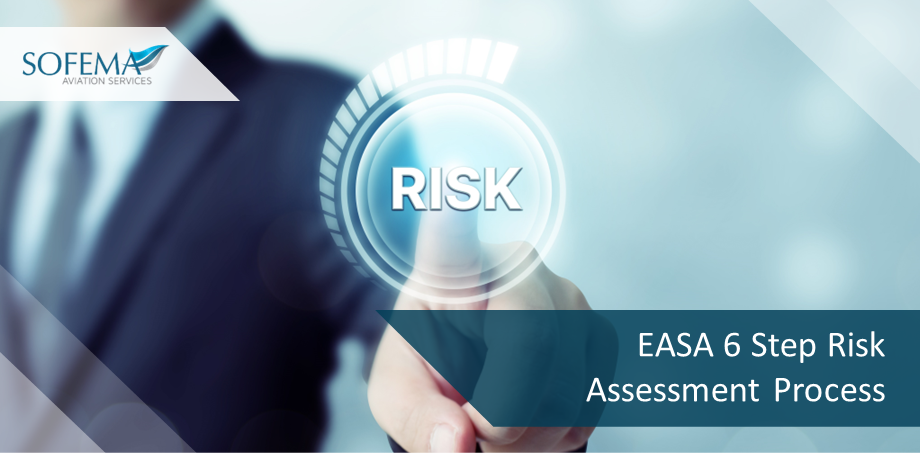Sofema Aviation Services (SAS) www.sassofia.com considers the use of EASA 6 Step Risk Assessment Process
Introduction
The EASA 6-step risk assessment process is a valuable tool for improving safety in aviation operations by helping operators identify and manage risks in a structured and systematic way
- Provides a widely recognized approach for identifying and managing risks in aviation operations.
- The process recommends appropriate risk mitigation measures, such as changes to procedures, equipment, or training, to reduce the likelihood and/or severity of identified risks.
Key Features and Benefits of EASA 6 Step Risk Assessment Process
Some key features and benefits of this process include:
- Systematic approach: The process follows a structured and systematic approach that helps ensure that all potential risks are identified and assessed in a consistent and comprehensive manner.
- Clear methodology: The process includes clear steps and guidelines for assessing risks, which makes it easier for operators to understand and apply.
- Identifies hazards: The process identifies hazards that could affect safety, such as weather conditions, technical malfunctions, or human factors.
- Assesses risk: The process evaluates the likelihood and severity of potential safety hazards, which helps prioritize risks and determine appropriate mitigation measures.
Using the EASA 6 Step Risk Assessment Process
By following this six-step process, aviation operators can effectively identify and mitigate risks, ensuring the safety of their operations.
- Hazard Identification: Identify potential hazards that could affect the operation. This includes everything from equipment failures to environmental conditions.
- Risk Assessment: Assess the likelihood and severity of each identified hazard. This step involves determining the probability of the hazard occurring and the consequences of the hazard if it does occur.
- Risk Mitigation: Develop and implement measures to reduce the likelihood or severity of the hazards. This could include things like maintenance procedures, training programs, or operational changes.
- Risk Acceptance: Determine if the residual risk is acceptable. If not, additional mitigation measures should be identified and implemented.
- Risk Communication: Communicate the risks and mitigation measures to all relevant stakeholders. This includes pilots, maintenance personnel, and others involved in the operation.
- Risk Monitoring: Continuously monitor the operation and review the risk assessment process on a regular basis. This helps ensure that the mitigation measures are effective and that new risks are identified and addressed.
Additional Considerations when using EASA 6 Step Risk Assessment Process
While the EASA 6-step risk assessment process is a valuable tool for identifying and mitigating risks in aviation operations, its limitations and shortcomings must be carefully considered to ensure that it is used effectively and appropriately.
- Subjectivity: The EASA 6-step risk assessment process involves subjective judgments by operators and assessors, which may result in inconsistent or biased risk assessments.
- Limited scope: The process focuses primarily on technical and operational risks, and may not fully capture other important risk factors such as human factors, organizational culture, and environmental factors.
- Lack of guidance: The process does not provide clear guidance on how to weigh the severity of different risks, or how to prioritize them in a complex operational environment.
- Resource-intensive: The process requires significant time, resources, and expertise to implement effectively, which may make it difficult for smaller operators or organizations with limited resources to use effectively.
- Limited feedback: The process does not provide effective feedback to operators, which may limit their ability to learn from previous incidents and improve their risk management processes.
- Limited accountability: The process may not hold operators or individuals accountable for their risk management decisions, which may lead to a lack of incentive to improve risk management practices.
Next Steps
Follow this link to our Library to find & Download related documents for Free.
Sofema Aviation Services (www.sassofia.com) and Sofema Online (www.sofemaonline.com) provide Classroom, Webinar & Online EASA Regulatory-Compliant and Vocational Training Courses, for questions please email team@sassofia.com
Tags:
aviation, aviation safety, EASA, Human Factors, Risk Assessment, Sofema Aviation Services, Assessment, Mitigation, Hazards, Aviation SMS, Aviation Risk, SAS blogs, SAS training, Aviation Operations, Safety Hazards, 6 Step Risk Assessment Process





